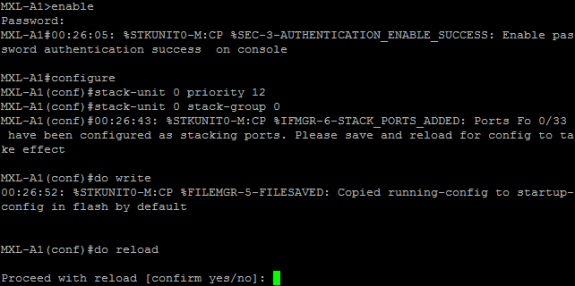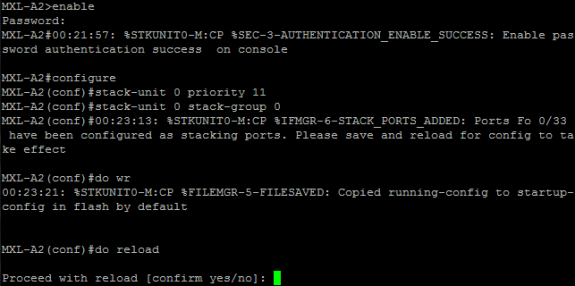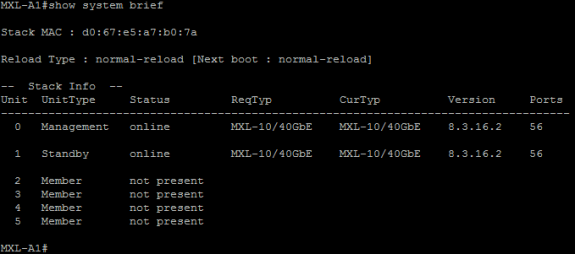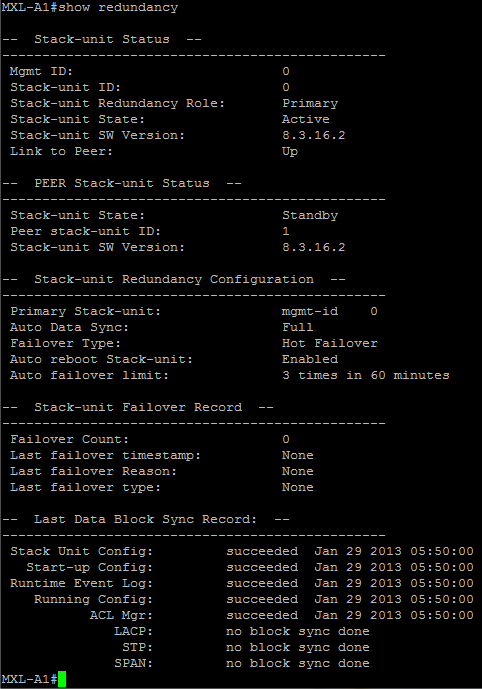I have two Dell MXL blades [FTOS 8.3.16.2] in a M1000e chassis with a MXL blade in slot A1 and slot A2 as shown below. The ‘fortyGigE 0/33’ port on each switch is connected to the other via a 40 GbE QSFP+ Passive DAC cable. Dell MXL blade switches support both ring and daisy chain topologies. In this example, I simply daisy chain two MXL blades to create one logical switch that can be managed as one unit. In a typical scenario, VLT can then be employed from two ToR switches down to the MXL stack using the two free fixed 40GbE ports; however, I do not demonstrate this VLT configuration here. To see VLT configuration see my prior blog “Dell Force10 – Layer 2 Multipathing via Virtual Link Trunking (VLT)”
Stacking can only be done using 40GbE ports and each port is mapped to a specific stack group, so the first thing I do is check to see which 40GbE ports map to which stack groups as shown below.
From the output of ‘show system stack-unit 0 stack-group’, I can see that ‘fortyGigE 0/33’ is mapped to stack group 0. Note, I do not have any 40GbE modules inserted in either of the two FlexIO slots, so I can only use stack-group 0 or stack group 1 for stacking. To see if I have any modules inserted in the FlexIO slots I can use the ‘show inventory optional-module’ command as shown below.
My setup on the MXL blade in slot A2 is the same ast that of the MXL in slot A1. On the MXL in slot A1, I set its priority to 12 and set its ‘fortyGigE 0/33’ port to a stacking port and reload. On the MXL in slot A2, I set its priority to 11 and set its ‘fortyGigE 0/33’ port to a stacking port and reload. The switch set to a higher priority becomes the management switch for the stack and the other switch becomes standby. The default priority for every switch is 0, so you must change this manually to deterministically set the primary and secondary management units. The highest MAC address is used to break any ties between all member units.
The ‘show system brief’ command can be used to see the unit IDs present in the stack. Note below, the MXL blade in slot A2 has been given a unit number of 1. If you want to control the unit number that will be assigned to a specific MXL switch you can do so with the ‘stack unit
The ‘show redundancy’ command can be used for even more details on the stacking status such as when the management unit last failed-over.
If an issue with stacking is suspected, you can check the status of the stacking ports with the ‘show system stack-port status’ command as shown below.












 Twitter
Twitter LinkedIn
LinkedIn Youtube
Youtube RSS
RSS
7 Responses to Stacking the Dell MXL Blade Switch